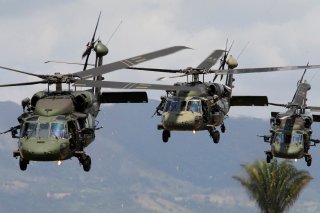The Army Is Preparing to Send Unmanned Helicopters to War
A U.S. Army UH-60 Black Hawk helicopter recently conducted a fully autonomous flight without a pilot.
A U.S. Army UH-60 Black Hawk helicopter recently conducted a fully autonomous flight without a pilot, a significant development in the ongoing effort to develop aircraft with more sophisticated levels of autonomy.
The Black Hawk took off from a runway at Fort Campbell and performed a thirty-minute mission that included pedal turns, maneuvers, and various autonomous adaptations to specific mission environments, finishing with what developers called a “perfect landing.”
The first-of-its-kind unmanned Black Hawk flight emerged as a result of a coordinated program between Lockheed Martin, its Sikorsky subsidiary, and the Defense Advanced Research Projects Agency (DARPA) that used breakthrough hardware and computer algorithms to enable autonomous flight. The DARPA program, called the Aircrew Labor In-Cockpit Automation System (ALIAS), draws upon advanced computer automation and sensors to gather and organize data and adapt as needed to specific mission demands by performing procedural functions without human intervention.
“With ALIAS, the Army will have much more operational flexibility,” Stuart Young, program manager in DARPA’s Tactical Technology Office, said in a DARPA statement. “This includes the ability to operate aircraft at all times of the day or night, with and without pilots, and in a variety of difficult conditions, such as contested, congested, and degraded visual environments,” Young added.
This breakthrough is the culmination of years of research and experimentation with artificial intelligence and computer automation, resulting in previously unimaginable levels of in-flight autonomy. While course correcting programs such as fly-by-wire have existed in the past and the Army envisioned measures of autonomy years ago during the inception of its Future Vertical Lift program, this development represents the beginning of a new frontier in military aviation.
Programs like ALIAS take these initial measures of autonomy into a new realm of fully autonomously flying, something Army scientists, researchers, and engineers have been working on for many years. However, while there are certainly some missions—such as resupply, surveillance, or certain kinds of attacks—that could be better performed by an unmanned helicopter, the current thinking is that the unique advantages of human cognition are not expected to disappear anytime soon. Both humans and technology are needed to reach the Army’s sought-after vision of man-machine interface. In the early days of the conceptual development of the Army’s Future Vertical Lift program, the Army sought to develop advanced computer algorithms for critical data gathering and processing functions while humans remained in a command and control function. The idea of man-machine synergy is rooted in the recognition that there are simply just too many faculties and variables unique to human cognition that cannot be replicated by computers.
Kris Osborn is the defense editor for the National Interest. Osborn previously served at the Pentagon as a Highly Qualified Expert with the Office of the Assistant Secretary of the Army—Acquisition, Logistics & Technology. Osborn has also worked as an anchor and on-air military specialist at national TV networks. He has appeared as a guest military expert on Fox News, MSNBC, The Military Channel, and The History Channel. He also has a Master's Degree in Comparative Literature from Columbia University.
Image: Reuters.

